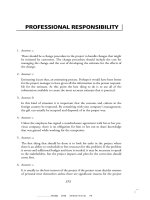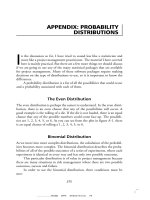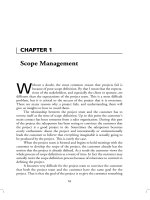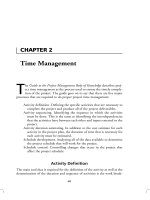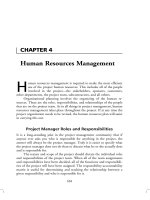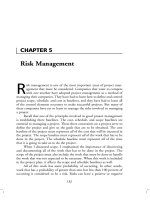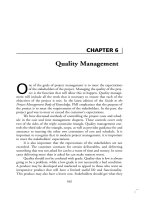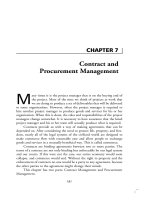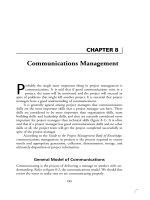Management Presentation Chapter 1
Bạn đang xem bản rút gọn của tài liệu. Xem và tải ngay bản đầy đủ của tài liệu tại đây (685.43 KB, 39 trang )
Netflix Case
• In 1977, Reed Hastings incurred a $40 late fee at
Blockbuster.
– Gym has a much better business model! Pay
• Unlimited Rentals by mail for a flat fee – No due
date/late fee
• In 2011, Netflix’s market cap stood at nearly $10
billion and would reach nearly $15 billion.
• Separate DVD-by-mail and VoD streaming
services (Result in losing 810,000 customers and
market share lost 31%)
• Combine the two services again
What is Management?
• Engaging in a set of activities
– Planning and decision making, organizing, leading,
and controlling
• Using an organization’s resources
– Human, financial, physical, and information
• Achieving organizational goals
in an efficient and effective manner.
Basic Responsibility of Management
EFFICIENTLY
Using resources wisely and
in a cost-effective way
and
EFFECTIVELY
Making the right decisions and
successfully implementing them
An Introduction to Management
• Organization
– A group of people
working together in
structured and
coordinated fashion to
achieve a set of goals
• Types of
Organizational Goals
– Profit-seeking
– National defense
– Discovery of knowledge
– Coordination
– Social needs
What is a Manager?
• Someone whose primary responsibility is
to carry out the management process.
– Plans and makes decisions, organizes, leads,
and controls human, financial, physical, and
information resources.
FIGURE 1.2
The Management Process
FIGURE 1.1
Kinds of Managers by Level and Area
• For example: CEO, CFO, COO,
President, Vice President, etc.
• Responsible to set goals and direct
the org to achieve them.
• For example: General Manager,
Plant Manager, Regional Manager,
and Divisional manager.
• Carrying out the goals set by top
management.
• For example: Office manager, Shift
Supervisor, Department manager,
Store manager, etc.
• They oversees day to day
operation in their own
department/area.
Kinds of Managers by Level
• Top Managers
– Executives who manage the organization’s overall
goals, strategy, and operating policies.
• Middle Managers
– Largest group of managers in organizations
• Implement top management’s policies and plans.
• Supervise and coordinate lower-level managers’ activities.
• First-Line Managers
– Supervise and coordinate the activities of operating
employees.
– Oversee day-to-day operations
Kinds of Managers by Area
Marketing
Managers
Financial
Managers
Operations
Managers
Human Resources
Managers
Kinds of
Managers
by Area
Administrative
Managers
Specialist
Managers
What Skills Do Managers Need?
Technical
Conceptual
Interpersonal
Fundamental
Management
Skills
Diagnostic
Decision
Making
Communication
Time
Management
Fundamental Management Skills
• Technical
– The skills required for work done in an organization.
• Interpersonal
– The ability to communicate with, understand, and
motivate both individuals and groups.
• Conceptual
– The ability to think in the abstract.
• Diagnostic
– The ability to visualize the appropriate response to
a situation.
Fundamental Management Skills (cont’d)
• Communication
– The ability both to convey and to receive ideas
and information effectively from others.
• Decision-Making
– The ability to recognize and define problems and
opportunities and then to select a course of action
to solve problems and capitalize on opportunities.
• Time-Management
– The ability to prioritize work, to work efficiently,
and to delegate appropriately.
Management: Science or Art?
• The Science of Management
– Assumes problems can be approached using rational,
logical, objective, and systematic ways.
– Requires technical, diagnostic, and decision-making
skills and techniques.
• The Art of Management
– Requires a blend of intuition, experience, instinct, and
personal insights.
– Requires conceptual, communication, interpersonal,
and time-management skills to accomplish managerial
tasks activities.
The Importance of Theory and History
• Why Theory?
– Provides a conceptual framework for organizing
knowledge and providing a blueprint for action.
• Managers develop their own theories.
• Why History?
– An awareness and understanding of historical
developments in management are important.
• Furthers development of management practices.
• Avoids mistakes of others in the past.
The Study of Management
• The Classical Management Perspective
– Scientific Management
– Administrative Management
• The Behavioral Management Perspective
– The Hawthorne Studies
– The Human Relations Movement
– Contemporary Behavioral Science in Management (Organizational
Behavior)
• The Quantitative Management Perspective
– Management Science
– Operations Management
• Contemporary Management Perspectives
– They System Perspective
– The Contingency Perspective
The Classical Management Perspective
• Scientific Management
– Concerned with improving the performance of individual
workers (i.e. efficiency).
– Focus: Try to resolve labor shortage and low productivity.
– The earliest advocate is Frederick Taylor (1856–1915)
• Replaced old work methods with scientifically-based work methods.
– Eliminated “soldiering,” where employees deliberately worked at a pace
slower than their capabilities.
– He studied and timed each element of the steel workers’ jobs. He
determined what each worker should be producing, and then he designed
the most efficient way of doing each part.
– He invented “piecework pay system”. Work more, get paid more!
Scientific Management
– Believed in selecting, training, teaching, and
developing workers. Follow this guideline would
improve the efficiency workers.
Steps in Scientific Management
Administrative Management
• Administrative Management
– Focuses on managing the total organization
rather than individuals.
– The primary contributors was Henri Fayol (1845–
1925)
• Identified the specific management functions of planning,
organizing, leading, and controlling.
– Max Weber: His work on bureaucracy laid the
foundation for contemporary organization theory,
which is discussed in detail in Chapter 6.
Classical Management Perspective
• Contributions
– Laid foundation for later
developments.
– Identified important
management processes,
functions, and skills.
– It made management a
valid subject of scientific
inquiry
• Limitations
– More appropriate for use in
traditional, stable, simple
organizations. (opposite from
today)
– Prescribed universal
procedures that are not
appropriate in some settings.
– Employees viewed as tools
rather than as resources.
They are motivated only by
money.
Behavioral Management Perspective
• Emphasized the importance of individual
attitudes and behaviors, and group processes.
– Hugo Munsterberg (1863–1916)
• Is recognized as the father of industrial psychology
• Advocated applying psychological concepts to employee
selection and motivation.
– Mary Parker Follett (1868–1933)
• Recognized importance of human behavior in the workplace.
The Hawthorne Studies (1927–1932)
• Conducted at Western Electric by Elton Mayo
– Illumination study
• Manipulating illumination for one group of worker (experimental
group) and comparing their subsequent productivity with the other
group (control group).
– Group study for Piecework Incentive Pay Plan
• Incentive pay plan caused workers to establish informal levels of
individual output.
– Over-producing workers were labeled “rate busters.”
– Under-producing workers were considered “chiselers.”
– To be accepted by the group, workers produced at the accepted level.
– Interview program
• Confirmed importance of human behavior in the workplace.
• Individual and social processes play major roles in shaping worker
attitudes and behavior
Behavioral Management Evolves
• The Human Relations Movement
– Grew from the Hawthorne studies.
– Proposed that workers respond primarily to the social
context of work, including social conditioning, group
norms, and interpersonal dynamics.
– Assumed that the manager’s concern for workers
would lead to increased worker satisfaction and
improved worker performance.
Human Relations View of Management
Individual Needs and Motives
Supervisor
Social
Context
Manager shows his concern for workers
Individual
Responses
Increased worker satisfaction and improved
worker performance
Task
Behavioral Management Theorists
• Abraham Maslow (Maslow’s Hierarchy of
Needs will be discussed in Chapter 10)
– Advanced a theory that employees are motivated
by a hierarchy of needs that they seek to satisfy.
• Douglas McGregor
– Proposed Theory X and Theory Y concepts
of managerial beliefs about people and work.
